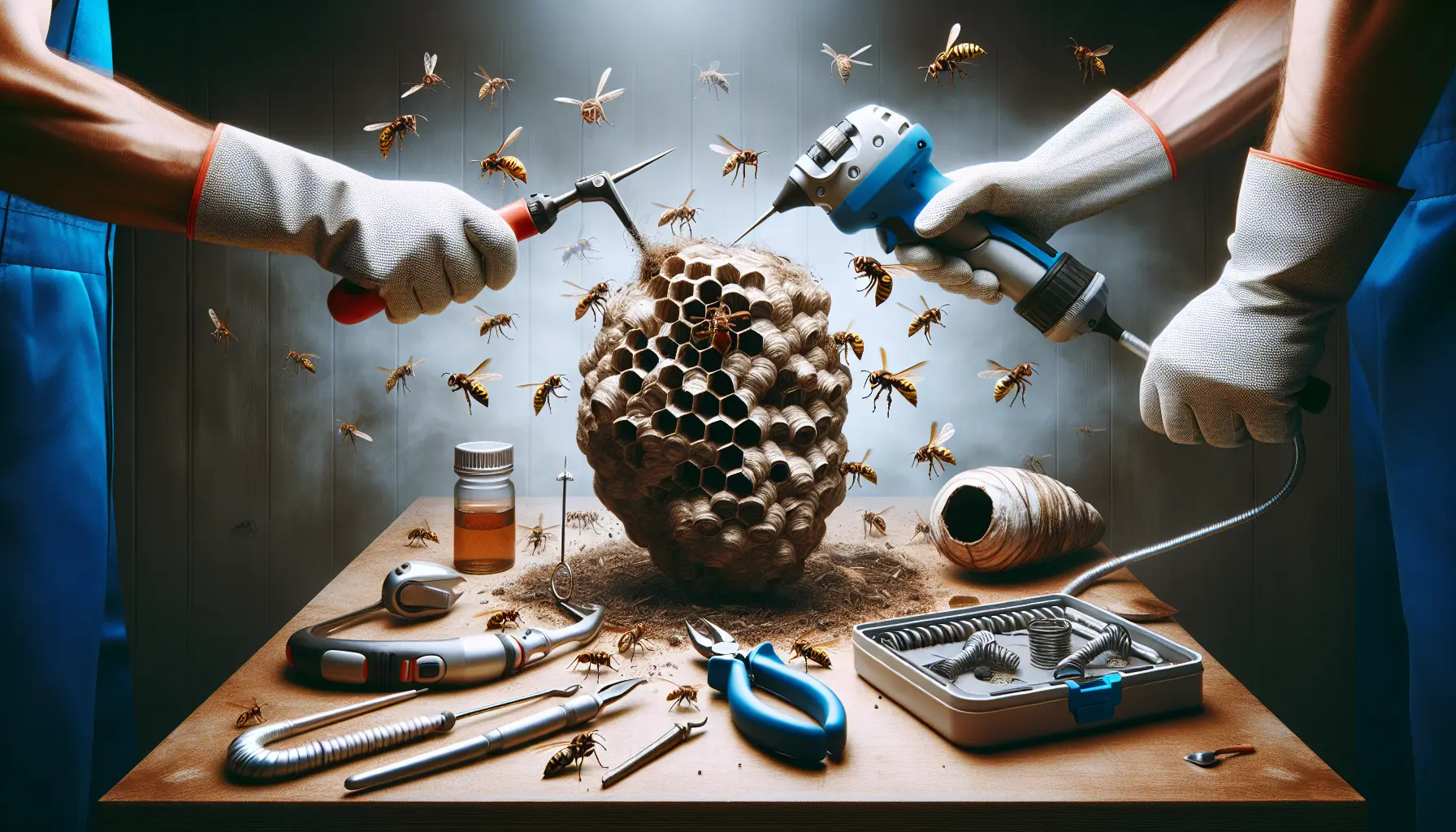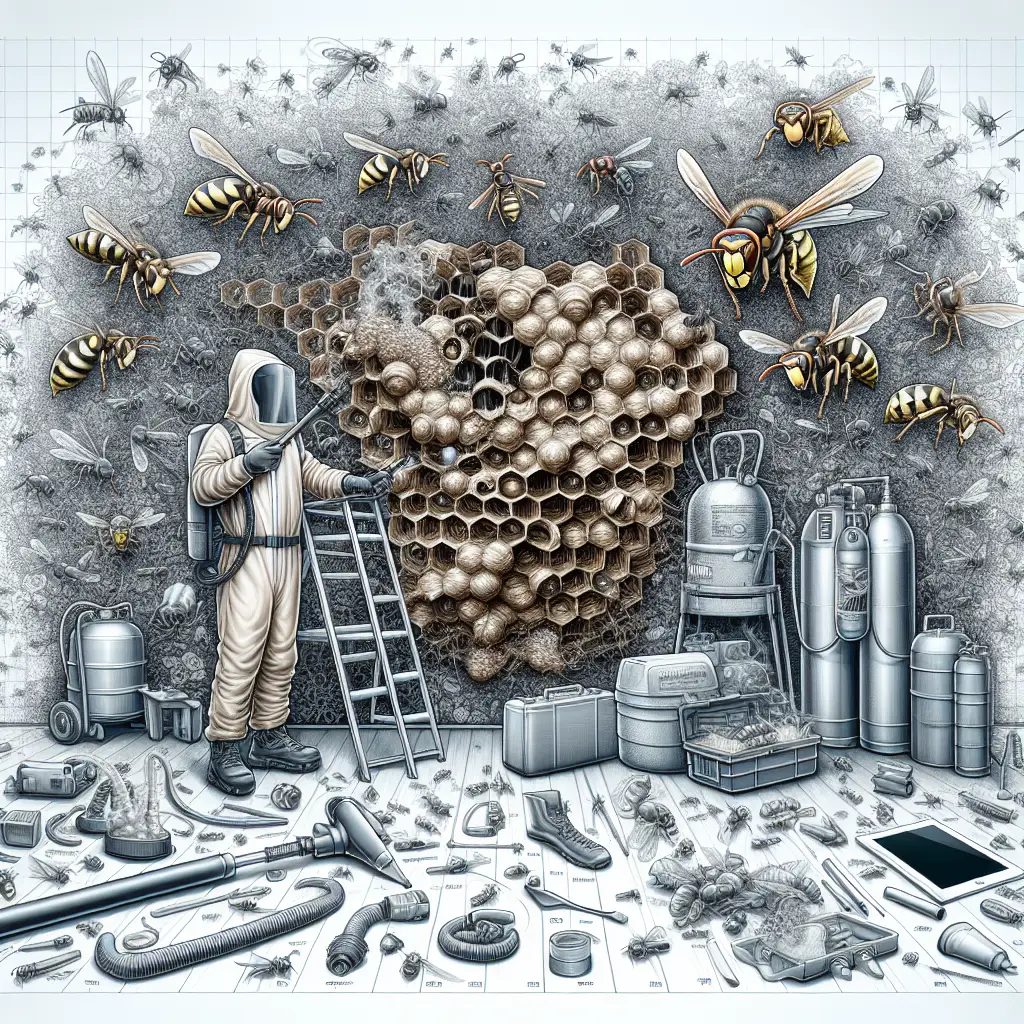Why Hornets Are a Big Problem in the UK
Hornets can turn your quiet garden or loft into a danger zone. These large and aggressive wasps pack a powerful sting and tend to defend their nests with fury. In the UK, we mostly deal with the European hornet, but in recent years, the Asian hornet has made an appearance, which is even more aggressive and a threat to native bee populations.
When hornets build nests around your home, whether in your attic, shed, or wall cavities, they quickly become a hazard. That danger multiplies if you try to deal with the nest the wrong way. Removing a hornet nest isn’t like swatting a fly; it takes planning, safety gear and knowledge. That’s where we come in. At Wasps-R-Us, we’ve been dealing with hornet nests for years, and we’ve picked up some expert tricks along the way.
In this article, we’ll go over different ways to remove hornet nests safely, how to spot them early, and when to call in the professionals. We’ll even tell you how to avoid getting a nest at all next season.
Spotting a Hornet Nest Before It Becomes Dangerous
Hornets don’t hide away forever, they’re busy little builders. Most hornet nests start small, about the size of a golf ball in spring, and grow rapidly over the summer until they reach basketball size or even larger. Finding the nest early can give you time to take safe action before things escalate.
Look out for these signs near your home:
- Frequent hornet traffic near a single spot, such as a roof overhang, wall cavity or bush.
- A grey paper-looking nest built from chewed wood, either hanging from a branch or tucked into hidden spaces.
- Buzzing sounds are coming from the walls or high places in your attic.
- Hornets flying in a straight line at dusk or dawn, usually going to and from the nest.
If you spot any of these signs and you’re unsure whether it’s hornets or wasps, it’s best to leave it alone and avoid getting too close. Hornets are defensive and will attack if they think you’re a threat.
Still not sure? Visit Wasp Nest Removal UK for visual guides to help identify the type of stinging insect you’ve got around your home.
Understanding Hornet Nest Dangers
Hornet stings aren’t just painful; they can be dangerous, especially for people allergic to venom. Unlike bees, which sting once, hornets can sting multiple times. Their venom is strong and can cause severe reactions, including swelling, difficulty breathing or even hospital visits in extreme cases.
Hornets are even more likely to sting when their nest is disturbed. That’s why Do-It-Yourself hornet nest removal can backfire badly. Walking up to a nest and giving it a poke with a broom won’t solve your hornet problem; it will only make them angry.
At Wasps-R-Us, we’ve seen many hornet removal attempts go wrong, with people ending up in A&E. Always wear protective clothing if you must get near a nest, and never try to remove a large or well-established nest without help.
Safe Hornet Nest Removal: What Works
There’s no one-size-fits-all approach to hornet nest removal. The method depends on the nest’s size, location and accessibility. But here are the safest and most effective ways we’ve found to handle them:
1. Use Approved Insecticidal Spray (carefully)
If the nest is small and you’re confident, you could use a hornet-specific insecticidal spray. Only attempt this at night or early morning when hornets are less active. Always wear full-body protective gear.
- Spray at the base of the nest entrance, not directly at the nest.
- Keep a safe distance.
- Never use water or fire.
Even then, remember this option only works for very early nests that are easy to reach. Anything bigger or higher will need expert help.
2. Use a Professional-Grade Dust Insecticide
Professional pest controllers often use dust formulas that are puffed into the entrance hole. This clings to the hornets as they enter and exit, wiping out the colony without angering the entire nest at once. This method works well for nests inside wall voids or unreachable areas.
3. Nest Removal After Inactivity
Once the colony dies off or is treated successfully (usually after a week), the nest can be removed from your attic or garden shed. We always recommend this only after ensuring there’s zero activity from any remaining hornets.
If you’re unsure which approach is safe for your situation, your best bet is to contact experts like Wasp Nest Removal UK. They’re equipped with the right tools, treatments and gear to manage danger zones safely.

Why Call In the Professionals
Hornet nest removal can involve climbing ladders, squeezing into small loft traps and facing angry insects with painful stings. Sounds like fun, right? We didn’t think so either. That’s why professional pest control teams exist: to keep you safe while getting rid of pests quickly and thoroughly.
Here are just a few reasons we recommend calling Wasps-R-Us or another trained pest controller:
- We assess the risk and choose the right method.
- We wear protective suits to avoid stings.
- We use industrial-grade powders and sprays that work better than shop-bought options.
- We follow all laws around insecticide use and protect the environment while we work.
Even better, professionals can offer prevention tips tailored to your property to stop hornets from coming back again next year.
You can book support quickly and easily on Wasp Nest Removal UK. Just tell them what you’ve seen, and their local pest control technician will sort you out.
How to Prevent Hornet Infestations
Once you’ve had a hornet nest on your property, preventing it from happening again becomes a priority. We’ve learned that hornets love quiet, undisturbed areas to build in. If you give them fewer hiding spots, they’re far less likely to move in.
Here’s what you can do:
- Seal any small gaps in your walls, roof or attic vents.
- Keep bushes and hedges trimmed to reduce hidden nest spots.
- Install fine-mesh screens over vents and air bricks.
- Check your attic or loft regularly in spring and summer.
- Remove food sources, including fallen fruit and open bins.
Some people try using decoy nests, which make hornets think another colony is already there. While not 100% guaranteed, they can sometimes work as a deterrent.
By following these simple steps, you can reduce the chances of hornets returning and keep your summers much more peaceful.
FAQs
How dangerous are hornets in the UK?
Hornets can deliver painful stings and are very protective of their nests. While not usually deadly, they can cause serious allergic reactions in some people.
Can I remove a hornet nest myself?
Technically, yes, but it’s extremely risky. DIY attempts often fail or lead to stings. Unless the nest is brand-new and very small, call in a professional like Wasps-R-Us.
What time of day is best to treat a hornet nest?
Evening or early morning, when hornets are less active and all members are inside the nest.
Do hornets die off in winter?
Yes. Most hornets die naturally in winter, but the queen survives and starts a new nest the following spring. That’s why yearly checks are useful.
Is hornet removal safe for children and pets?
When done by professionals, yes. The treatment is applied in a way that minimises risk to people and animals. Always keep children and pets away until the technician says it’s safe.
Final Thoughts and What To Do Next
Hornet nest removal isn’t something to take lightly. From painful stings to real injury risks, doing it wrong can have serious consequences. Whether you’ve got a buzzing nest in your garden or you’re not sure what insect you’re dealing with, we recommend playing it safe.
At Wasps-R-Us, we’ve tackled thousands of nests and know the best way to get the job done safely. Say goodbye to hornet infestations by reaching out to experts who know how to protect your home and health.
If you need help or advice, visit Wasp Nest Removal UK and book a local technician today. Let’s get your hornet problem sorted!



 Blog
Blog